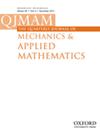Hydrodynamics of fluid around a collapsing bubble in the spark bubble droplet generation process
IF 0.8
4区 工程技术
Q3 MATHEMATICS, APPLIED
Quarterly Journal of Mechanics and Applied Mathematics
Pub Date : 2014-08-01
DOI:10.1093/QJMAM/HBU011
引用次数: 3
Abstract
Summary This article aims to study in detail the bubble oscillation near confined free surfaces and the ensuing droplet formation using a combined boundary element-finite difference method. Three configurations are considered: (i) the bubble oscillation near a circular aperture made in a flat plate, (ii) the bubble oscillation inside and near the top opening of a vertical cylinder and (iii) the bubble oscillation between a perforated flat plate and a horizontal solid boundary. The effects of standoff distance on the bubble dynamics and on the surrounding fluid dynamics are examined. Completely different bubble shapes, free surface motions, jetting patterns and pressure distributions under different standoff distances could be observed in the present work. In addition, it was found that for the configurations (i) and (iii), the bubble reentrant jet is always directed away from the free surface. For the cylinder case, however, a critical standoff distance was found for which the pressure distribution in the fluid above and below the bubble are the same and the bubble takes the shape of an hourglass at the time of jet impact. For subcritical standoff distances the bubble reentrant jet is always away from the free surface. However, for supercritical standoff distances the direction of the reentrant jet is interestingly directed towards the free surface. Finally, the effect of plate and cylinder configurations on the resulting droplet dynamics was investigated. It was found that the driving force for the droplet formation is the initial velocity induced by the bubble reentrant jet rather than the pressure difference inside the liquid. Besides, in the cylinder case the droplet size is smaller and its pinch-off happens earlier than the plate case.火花气泡液滴产生过程中气泡崩塌周围流体的流体力学
本文采用边界元-有限差分联合方法详细研究了气泡在受限自由表面附近的振荡和液滴的形成。考虑了三种结构:(i)平板上圆形孔附近的气泡振荡,(ii)垂直圆柱体顶部开口内部和附近的气泡振荡,以及(iii)穿孔平板和水平固体边界之间的气泡振荡。研究了隔距对气泡动力学和周围流体动力学的影响。在不同的距离下,可以观察到完全不同的气泡形状、自由表面运动、喷射模式和压力分布。此外,我们还发现,对于构型(i)和(iii),气泡重入射流总是指向远离自由表面。然而,对于汽缸壳体,发现了一个临界距离,在这个距离内,气泡上方和下方的流体压力分布相同,并且气泡在射流撞击时呈沙漏形状。对于亚临界距离,气泡射流总是远离自由表面。然而,对于超临界距离,再入射流的方向有趣地指向自由表面。最后,研究了平板和圆柱构型对液滴动力学的影响。结果表明,液滴形成的驱动力是气泡射流诱导的初始速度,而不是液体内部的压差。此外,在圆柱壳中,液滴尺寸比板壳小,其夹断发生得早。
本文章由计算机程序翻译,如有差异,请以英文原文为准。
求助全文
约1分钟内获得全文
求助全文
来源期刊
CiteScore
1.90
自引率
11.10%
发文量
14
审稿时长
>12 weeks
期刊介绍:
The Quarterly Journal of Mechanics and Applied Mathematics publishes original research articles on the application of mathematics to the field of mechanics interpreted in its widest sense. In addition to traditional areas, such as fluid and solid mechanics, the editors welcome submissions relating to any modern and emerging areas of applied mathematics.

 求助内容:
求助内容: 应助结果提醒方式:
应助结果提醒方式:


